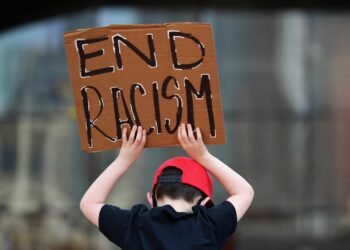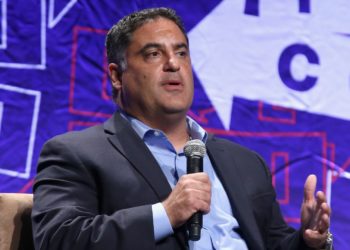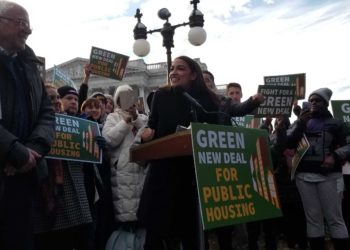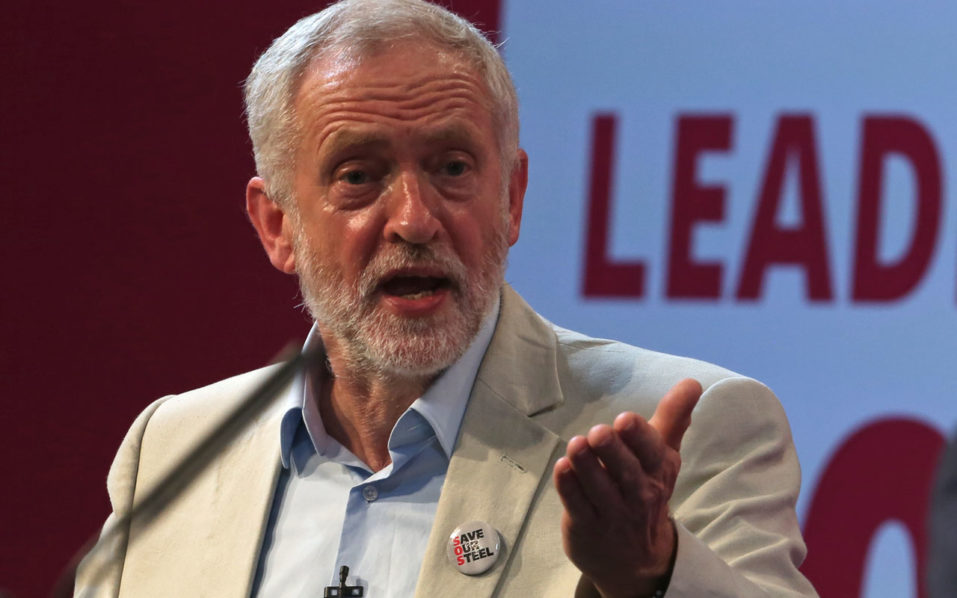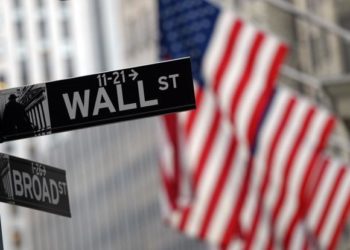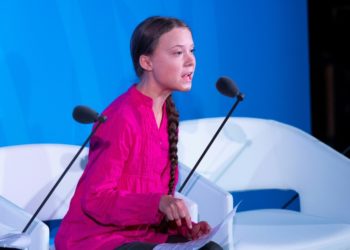Until recently, the “Green New Deal” was a concept only discussed in wonkish, left-wing circles of American political discourse.
The term had been used in the Green Party’s platform for more than a decade and was a centerpiece of Jill Stein’s 2012 and 2016 campaigns for president. And though the term trickled into the vernacular of progressive Democrats, particularly during and after Bernie Sanders 2016 presidential campaign, it was still largely relegated to the realm of relative political obscurity.
All that changed on November 13, 2018, when a large group of young climate activists with the Sunrise Movement held a sit-in in soon-to-be Speaker of the House Nancy Pelosi’s office. Demanding bold action to address climate change and the formation of a Select Committee for a Green New Deal, the protesters were joined by Rep.-elect Alexandria Ocasio-Cortez, who was already a rising star in the Democratic Party.
Ocasio-Cortez, like other candidates from the Justice Democrats organization, had run on a Green New Deal on her way to pulling off one of the great electoral upsets in modern American history. Her presence at the rally became a well-covered story in the national press, and suddenly, for the first, the Green New Deal began being talked about on major network television and the pages of the legacy newspapers.
Pelosi never ended up allowing the creation of a Select Committee. But on February 7, Ocasio-Cortez and Senator Ed Markey unveiled the first ever framework proposal for a Green New Deal.
The proposal is as much a vision as it is a set of policies. Evoking the legacy of Franklin Delano Roosevelt’s New Deal program, the resolution calls for, among many other things, major public investment in renewable infrastructure including a public works program that would guarantee a job to anyone who wants one.
The goal of transforming America’s energy sector is admittedly ambitious, advocates say. But with the world’s leading scientists warning that the catastrophic consequences of climate change loom around the corner, the Green New Deal’s proponents argue that the time for action is yesterday.
“Five decades ago, President Kennedy announced the ambitious goal of sending an American safely to the moon. He didn’t say how it would be done, but that we would do it,” Markey said while announcing the resolution. “I say today that it time for us to be bold once again.”
Markey credited the Sunrise Movement with providing the necessary political foundation for the proposal to get traction on Capitol Hill.
“The difference between 2009-10 and today is the movement that has been built,” he said, gesturing towards the Sunrise activists on hand. “The green generation has risen up, and they are saying they want this issue solved.”
With a formal Green New Deal proposal now introduced in Congress, The Globe Post spoke to Aracely Jimenez-Hudis, a spokesperson for Sunrise, about the future of the movement and the group’s vision for the future of America.
Q: When the Sunrise movement began, I think most Americans had probably never heard of the Green New Deal. And in a very short period of time – particularly following the Sunrise demonstrations in Speaker Nancy Pelosi’s office – the issue has surged to national prominence. Have you guys had a moment to reflect on that at all? Does it feel vindicating being where we are now? Or is it more all eyes ahead realizing that there are still daunting challenges ahead of you guys?
Jimenez-Hudis: We’ve struck a pretty good balance of taking stock of how far we’ve have come in such a short amount of time. We do, of course, realize that what our movement has been able to achieve is pretty remarkable considering where U.S. climate politics was just a few months ago. But we are obviously very aware that bold ideas like a Green New Deal do face many obstacles moving forward. And that’s what throughout 2019, Sunrise is launching a whole campaign around the Green New Deal.
Q: Speaking of some of those obstacles, of course, the proposal has been met with scorn and a lot of opposition from Republicans. But even to some extent too, last week, Nancy Pelosi referred to the Green New Deal as “the Green Dream or whatever.” In her press conference with Ed Markey announcing the resolution, Alexandria Ocasio-Cortez was very diplomatic and gracious in responding to those comments. But particularly after you guys demonstrated in her office, was it disappointing for you to hear those comments? Did they feel dismissive to you?
Jimenez-Hudis: I don’t think so. I think that Nancy Pelosi, having been leader in the Democratic Party, is obviously trying to hold on to the power that they’ve gotten back after suffering through a decade of having to listen to the Republican Party in charge. And so really Sunrise really understand that our true targets are the fossil fuel billionaires who we know bankroll leadership in both parties. And for Sunrise it’s all about exposing that influence wherever it is regardless of where it is – whether it’s the Democratic or the Republican Party.
Q: In responding to those comments from Nancy Pelosi, journalist Natalie Shure I thought brought up a good point. She tweeted that a Green New Deal explicitly evokes one of the most popular moments in Presidential history, whereas a green dream evokes something more childish. And to that point about the wording of the Green New Deal, to people who aren’t so well versed in U.S. history, could you talk a little bit specifically about the evocation of the New Deal and the legacy of Franklin Delano Roosevelt in that era?
Jimenez-Hudis: Sure. The reason that the Sunrise movement, the climate movement, have gravitated toward naming the Green New Deal in memory of FDR’s original New Deal is trying to evoke the parallels between the times. So the New Deal was the response to the Great Depression. It was probably, obviously the worst economic disaster in living memory for the United States economy. And the New Deal was a massive investment in working people in this country.
Seeing the rampant income inequality that we see today, seeing how structural racism has influenced working class people in the United States, understanding how working-class communities and low income communities and communities of color are being affected first and hardest by climate disaster, we understand that in order to really save our planet and protect our environment for future generations and generations to come – we know that we can solve the issue of climate change while also investing in frontline communities and making sure that the Green New Deal doesn’t leave anybody behind.
Which of course is unfortunately one of the really really big flaws of the New Deal. We’ve been very careful to acknowledge that while the New Deal of FDR era was an incredible, visionary idea that essentially built the strongest middle class in U.S. history, we understand that while we can take that visionary challenge into the 21st century with the Green New Deal, we also know that we have to revamp it and make sure that the Green New Deal works for everyone.
Q: Keeping those flaws in mind, the New Deal in itself was was sort of incomplete, right? FDR had proposed a Second Bill of Rights and that included much of what is in the Green New Deal resolution that was unveiled by Senator Markey and Alexandria Ocasio-Cortez. He talked about the right to a decent home, the right to a decent job, the right to decent medical care. And I’m curious at the sunrise movement, how much are you guys students of that history? And when critics say that proposals like the Green New Deal are extreme, radical, unrealistic, even un-American, do you think it’s important to sort of remind those people of that history and the precedent of that era?
Jimenez-Hudis: Absolutely. I think it’s important to remind people that there’s really, essentially nothing more American than rising to a challenge and overcoming a seemingly insurmountable obstacle. And the best way to solve crises and issues like this is when we come together and when we bridge the divide of race and class and gender and every other demographic line that the Republican Party seeks to divide us by.
“There’s really, essentially nothing more American than rising to a challenge and overcoming a seemingly insurmountable obstacle.”
Q: And also on the inclusion of a lot of those visions in the Green New Deal proposal, obviously foundationally the Green New Deal is about decarbonization, it’s about renewable infrastructure, it’s about combating climate change. But it also proposes a much broader vision of the future of our of our politics. And because of that, there’s been a lot of criticism that this is just a progressive wish list or a bag grab. How would you respond to those criticisms?
Jimenez-Hudis: I think that there’s a long history of political and economic elites in this country telling the majority of the American people that we have to choose between issues to solve. And I think the beauty of the Green New Deal is that it shows us in very plain terms that we can solve all of these issues together. Modern social movements, all of these organizations that we’re working with on the Green New Deal with Alexandria Ocasio-Cortez, with these 70-plus co-sponsors in the House and Senate, we all understand that issues of medical care, issues of environmental justice, racial justice and economic justice, these issues are so interconnected that if we try to solve these issues piecemeal then things are inevitably going to slip through the cracks and not actually get solved. And the Green New Deal is sort of an antithesis to the lie that we’ve been told that says that we have to choose between say, saving our climate and a good, growing economy.
Q: And just to clarify for people as well, the resolution that was proposed by [Ocasio-Cortez] and Ed Markey is non-binding, right? It’s more about recognizing the challenges, it’s not like if this specific resolution were to be passed, all of a sudden there’d be 30 different policy proposals implemented, right?
Jimenez-Hudis: Yes that’s correct. The Green New Deal resolution is meant to steer the conversation going forward. The beauty of this resolution is that it takes stock of the most recent climate science and lays out a plan in line with what the world’s top scientists have told us is really necessary to curb catastrophic climate catastrophe.
“Special interests from coal, oil, and gas that have so infected the Republican Party, blatantly, but also infected the Democratic Party.”
Q: President Trump said yesterday evening that he thought the Green New Deal sounded like a “high school term paper.” And obviously he has pulled the United States out of the Paris climate accord leaving America alone in the world literally as the only country not a signatory to it. He’s put former fossil fuel lobbyists in charge of the EPA. He makes all kinds of jokes about climate change, most recently his comments about Amy Klobuchar’s presidential announcement speech.
But even with all that said and considered, he has spoken quite a bit about how he’d like to see a major infrastructure project going forward. And like the original New Deal, the Green New Deal foundationally, essentially is an infrastructure proposal, right? So do you think there might be any room at all to compromise going forward before 2020 on that kind of grounds or do you think it’s more likely that we’ll sort of just have to wait it out for a Democrat to ultimately become president in order to get the ball moving?
Jimenez-Hudis: Well see the thing is is that compromise isn’t really necessary because there have been studies, recent polls, that have shown that the majority of American voters, Democratic and Republican, strongly support a Green New Deal. So it’s really about exposing the fact that the reason that we don’t have bold, aggressive climate legislation like a Green New Deal on the table is because of the special interests from coal, oil, and gas that have so infected the Republican Party, blatantly, but also infected the Democratic Party. And so really our goal is to find candidates for 2020 all up and down the ballot who are totally devoid of special interest influence from the fossil fuel industry who can go up against the ideas of bought out politicians in primaries and in the general exposed to influence and say that we can do better and we can do better right now and we can have a Green New Deal.
Q: But as a matter of pure pragmatism, as it stands right this second, Donald Trump is the president and would have to sign any legislation into law. So if he wants to roll out some sort of major infrastructure bill, do you think that there’s an opportunity for Democrats to demand that at least a certain amount of that is renewable infrastructure and maybe that would be some sort of head start on what would ultimately be the Green New Deal? Or is that something that’s just not in your purview at this point?
Jimenez-Hudis: It’s not. it’s not really Sunrise’s strategy to try and shove something through before 2021. The way the Republican Party is so aligned with Trump right now, we know that no climate legislation and no infrastructure legislation that has such a heavy climate angle is going to go through, precisely because of the influences of fossil fuel money in the Republican Party and in the current administration. And so that’s why it’s the strategy throughout 2019 and throughout 2020 to really go hard on the 2020 election and build up our base around the country so that we can start organizing and electing climate champions all up and down the ballot. So in 2021, ideally, the dream is, of course, hold power in the house, take back the Senate and institute a new administration in the White House that’s going to pass a Green New Deal within the first hundred days.
“We’re bringing a message of hope and resilience to the climate movement. And having that message be spoken by youth I think inspires a lot of other young people to join us.”
Q: Almost every Democratic 2020 candidate at this point has at least expressed some kind of general support for the Green New Deal. But every time that they’re asked about it on major cable television news, they’re asked, “how are you going to pay for it?” On the face of it, I guess that seems like a fair question. But Alexandria Ocasio-Cortez has pointed out that those kinds of questions are rarely if ever, asked when it comes to increasing our already massive military budget or cutting taxes for the super-rich and major corporations.
Congressman Ro Khanna also brought up the question, well, how are we going to pay for the billions if not trillions of dollars of infrastructure damage and property loss that will be caused almost certainly by surging sea levels, more intense storms, wildfires, etc. if we do nothing. So those questions are also almost never brought up on these major cable television news programs in a serious way. Do you think that that tells us something about the kind of preexisting assumptions and biases that are right now embedded in our political discourse?
Jimenez-Hudis: Yeah I think that again, the fossil fuel industry has poured billions and billions of dollars over the past four decades to smear politicians who fight for climate legislation, to smash down even state level or local ballot measures that would address climate change in line with science. So Sunrise also recognizes that we’re up against a very powerful, very rich enemy – the fossil fuel executives, lobbyists, CEOs and the corporate PACs that they use to fund politicians.
We understand that the enemy is so heavily invested in protecting their own profits and this obscene amount of wealth that they’ve created for themselves that they have no interest in considering the horrific human cost of climate change.
And so I definitely think that this issue of bringing up costs when we want to promote justice and equality is absolutely bankrolled by special interest groups. And I also think that we see it across debates in progressive politics. That’s a question that always comes up when we talk about something like Medicare for all. People always ask, “Oh how are you going to pay for it? We can’t afford it.” We can afford it. It’s just people think that we can’t because Big Pharma has a huge campaign and they’ve poured billions of dollars into making the American people believe that we can’t ask for a healthcare system that treats everyone equally.
Q: Do you guys view the fight against climate change – in broad terms – to be kind of a generational struggle? Obviously, there are exceptions. There are young people who do not recognize the threat that climate change poses and there are, of course, many older people who absolutely do recognize the threat of climate change. But in very broad terms, does it feel like you guys – particularly as a youth organization – are up against a kind of generational struggle for the future of this country?
Jimenez-Hudis: Yeah, I definitely think that’s accurate. I also think that young people today are more acutely aware of what the effects of climate change and climate change fueled disasters are going to be on our lives. Many if not all of the leaders and members of the Sunrise movement as an organization have seen or felt firsthand the catastrophic effects of climate change and we’re bringing a message of hope and resilience to the climate movement. And having that message be spoken by youth I think inspires a lot of other young people to join us.
More on the Subject
In the wake of Hillary Clinton’s stunning loss to Donald Trump in the 2016 election, a group of disaffected former Bernie Sanders campaign officials and progressive media personalities quietly formed an organization with a simple mission: to take over the Democratic Party and remold it in their own vision.
Embracing their role as outsiders, Justice Democrats recruited and organized with dozens of candidates running in the 2018 midterm primaries. One of those candidates was Alexandria Ocasio-Cortez, a 28-year-old latina woman from the Bronx who had been working at a New York bar before running for Congress.
The Globe Post spoke to Alexandra Rojas, the executive director of Justice Democrats, to discuss the future of her organization and the Democratic Party.
Democratic Insurgents: An Interview with Justice Democrats Director Alexandra Rojas



